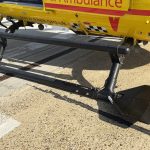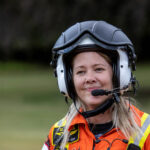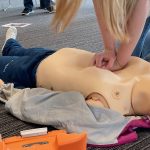3 Jun 2025
Beach taskings
EAAA crews can be tasked anywhere in Bedfordshire, Cambridgeshire, Norfolk and Suffolk, 24/7, to bring life-saving critical care to people experiencing medical emergencies. This can include to beaches.
There are approximately 140 miles of coastline in our region extending from The Wash off West Norfolk to the Stour and Orwell estuaries in Suffolk and, with the arrival of summer, more people will be heading to the seaside to enjoy the warmer weather. This means, EAAA crews can expect to be tasked more frequently to the coast to a wide variety of incidents, including cardiac arrests, accidental injuries and medical emergencies.
There are several considerations for the pilots and clinical crew when they are tasked to somebody on the beach who needs urgent critical care:
Unsurveyed landing sites
The pilots with EAAA are highly-skilled aviators with years of experience of flying to and landing at unsurveyed sites. This experience is essential when flying HEMS (Helicopter Emergency Medical Service) taskings where the flying is dynamic, and they never know where they may be tasked to next – including to the beach.
Deputy Medical Director, Dr Nicola, explains: “If the crew is tasked by air to the coastline, the pilots will first look at which beach it is and whether it is suitable to land on.”
This is the pilots’ decision, taking into consideration the 5S’s and AD principles (size, shape, slope, surface, surroundings, access to and from the landing site, and downwash – the powerful and unpredictable air generated by the helicopter rotor blades).
Tide times
The tide is also a crucial factor; is the tide in or out, and is it coming in, or going out? If it’s coming in, the pilots will need to be very aware of timings and potential alternative landing sites.
Collaborative working
Often incidents on a beach involve multi agency working, so collaboration with organisations including the Coastguard, lifeguards and the RNLI as well the police and ambulance service, is key.
“We can change channels on our crew radios if we need to speak to the Coastguard,” Dr Nicola says. “Before we arrive, they and other organisations often assist with the clearing and control of the incident site if the pilots choose to land on the beach. Crowd control is important because of the downwash created by the aircraft.”
Members of the public can assist the officials on site with clearing the beach where the helicopter is trying to land, such as securing towels and windbreaks, keeping dogs on leads, and children safe.
Patient focus
As with every person the crew attends when the crew arrive at their side their total focus is on the treatment and care of the patient. EAAA’s expert doctors and critical care paramedics provide critical care, including blood transfusions, advanced pain relief, sedation and anaesthesia, and surgical interventions at the scene. This critical care at the scene of medical emergencies, combined with quick onward transfer to the most appropriate hospital, gives every patient treated by EAAA the best possible chance of surviving and recovering a life-threatening emergency.
“Often our priority is to fly a patient off the beach to hospital for their ongoing treatment and care but depending on the nature of the emergency and access routes off the beach. It’s sometimes more appropriate for them to travel by a waiting land ambulance,” Dr Nicola says.
Wherever people experience medical emergencies this summer, it’s your support that will bring the advanced skills, medication and equipment – and hope – to the most seriously ill and injured people in East Anglia. Thank you.




